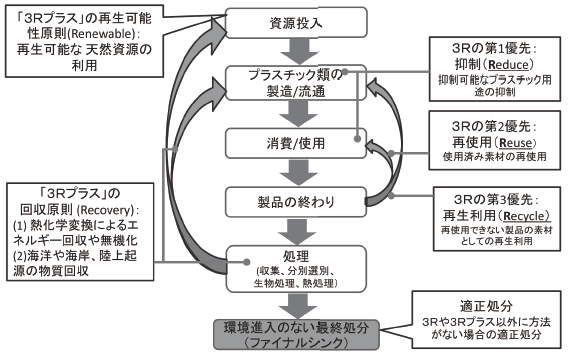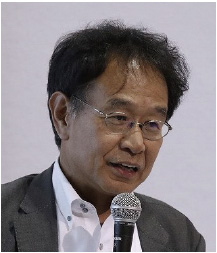- Information for Middle and High School Researchers
What kind of earth will we leave for our future children?
2020.10.08
What kind of earth will we leave for our future children?
Shinichi Sakai, Professor and Director, Center for Environmental Science, Kyoto University
I would like to transmit to the world, from Japan to the world, the future of a recycling-oriented society," says Shinichi Sakai, Director of the Center for Environmental Science at Kyoto University. He was involved in the formulation of the Plastic Circular Resource Strategy (2019), which aims to shift from the conventional one-way (linear) social structure of mass production, mass consumption, and mass disposal to a circular economic structure that circulates resources.
The 3Rs Plus Principle, a guideline for creating a sustainable state
In 2000, Japan enacted the Basic Law for Establishing a Sound Material-Cycle Society as a waste management measure, and has been a world leader in promoting the concept of 3Rs. 3Rs refers to the basic stance of moving away from a throwaway society: Reduce is the most desirable, followed by Reuse, and Recycle is the third most desirable. Recycle is the third most desirable. However, Mr. Sakai believes that the 3Rs alone are not sufficient, given the increasing amount of plastic emissions into the ocean and the environment that have left the control of humans and our continued dependence on depletable resources such as petroleum. He proposes the 3Rs Plus concept (Figure 1), which incorporates the promotion of the use of non-depleting resources (solar, wind, wave, and biological) as "Renewable" and the recovery of energy through thermochemical conversion and the collection of plastic waste from the ocean and beaches as "Recovery". Of these concepts, the concept of renewability in particular has been adopted in the draft Plastic Recycling Resource Strategy, which was formulated in 2019 and is beginning to move as an environmental policy.

Figure 1 Resource Circulation Flow of Plastic Materials and 3R Plus Concept
It is essential to build a system that captures society as a whole.
One of the most popular initiatives for reducing and reusing plastic bags is the nationwide introduction of a fee for plastic shopping bags in July 2020. The pioneer of this movement was the introduction of pay-as-you-go plastic bags around 2007, based on agreements among local governments, businesses, and citizen groups. In the case of Kyoto City, the total number of plastic bags used by the 10 stores that introduced the fee-based system fell from 39.2 million per year to 6.5 million per year, about one-sixth of the previous rate. However, more plastic is used to make My Bags more durable. It is important to note that buying numerous bags, as is the fashion, may use more material than a year's worth of plastic bags.
Also, in Recycle, society as a whole is making progress in collecting PET bottles, but other plastic products do not have a fixed raw material and some are now only reused as reductants in blast furnaces for iron, for example. Nevertheless, it is not realistic for consumers to sort by raw material, and "it is necessary to organize and build a collection method by product form that reflects the material," says Sakai. As major convenience stores have begun to set up collection points, it will be necessary to develop a social system that includes consumer behavior leading up to recycling.

Figure 2 Comparison of life cycle GHG emissions with and without polylactic acid material substitution ("BAU (Business As Usual) scenario" for the current processing system without material substitution)
One of the thermo-chemical transformations of Recovery is incineration. Although it would be ideal if everything could be recycled, masks and protective clothing contaminated with pathogens need to be incinerated for safety reasons, as has been the focus of recent attention. In addition, since it takes a lot of energy and resources to clean and sort soiled items, it may be better for the environment to incinerate them and recover the thermal energy. In all of these cases, it is not enough to consider only the circulation of plastic materials, but it is also necessary to look at the surrounding environment and determine what is best for society and the environment.
In terms of Renewable, bioplastics are attracting attention as a material. Dr. Sakai revealed that a 13.8% reduction in greenhouse gas emissions can be expected for representative bioplastics, polylactic acid and biomass polyethylene, over their entire life cycle from production to incineration (Figure 2). On the other hand, in terms of cost and function, bioplastics are inferior to petroleum-derived plastics, which have a 100-year history, and further research and development is needed to increase the use of bioplastics.
The Challenge of Transforming Concepts Across the Centuries
In the 20th century, priority was placed on mass production of better products and their widespread use in society, resulting in the formation of a linear society in which old and inferior products are no longer needed and are disposed of in large quantities. To realize a sustainable structure in which materials and energy circulate, as mentioned above, it is not enough to make major changes in one place, but rather, it is necessary to consider how each change will affect the others in every part of the social system. Mr. Sakai said, "This will be a challenge that will transcend the century. What we need to do is to accumulate success stories one at a time," and foresees that change will take a long time. In order to maintain a better society and environment for future generations, it will be important to continue to think and act on how to create a sustainable, recycling-oriented society.
*Reprinted from "Education Support vol. 47

